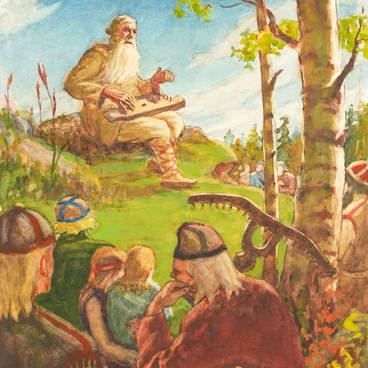Osmo Pavlovich Borodkin was a graphic artist. He was born in the Karelian village of Olanga. He graduated from the Petrozavodsk Pedagogical College in 1932. Five years later he enrolled in the Leningrad Art and Pedagogical Institute, but did not complete his studies: he was drafted to serve in the military. From 1941 to 1944, Borodkin served in partisan units in Karelia and the Arctic. After the war, he worked on illustrations for the “Kalevala” from 1947 to 1948. Unfortunately, he passed away in 1949 before completing the series. His work was recognized posthumously at the All-Union Competition for Illustrations of the “Kalevala”. It was held to celebrate the centenary of the complete edition of the epic poem. Borodkin received the 3rd degree prize at this competition.
The Karelian artist, Osmo Borodkin, was born in a region with a long history of epic songs. The map, showing Elias Lönnrot’s travels around Northern Karelia, features Borodkin’s native village of Olanga. From an early age, the artist was fascinated by ancient runes, having heard them repeatedly from his father, grandfather, and other residents of Olanga. While attending a middle school in Kestenga, Borodkin studied the poem as a main subject. From that time on, the “Kalevala” became a textbook of beauty and a source of wisdom for the artist.
Childhood memories associated with the poem were deeply embedded in Borodkin’s consciousness. They were brought to light, vividly and clearly, in the latter years of his life that he dedicated entirely to the “Kalevala”. He became the first Karelian artist to refer to the epic poem in his work.
Unfortunately, Osmo Borodkin’s work on the “Kalevala” remains unfinished. However, his artworks allow us to appreciate the extraordinary talent of the artist, albeit not fully developed, and his sophisticated and original interpretation of the ancient runes. Having no experience in book illustration, Osmo intuitively discovered the right approach to the visual representation of the “Kalevala”. These were the songs of his people, so he relied on them to guide him.


